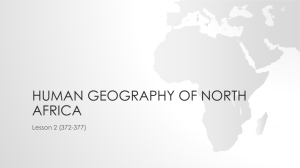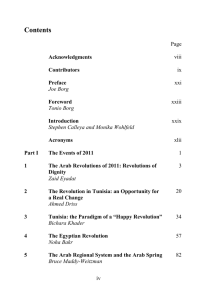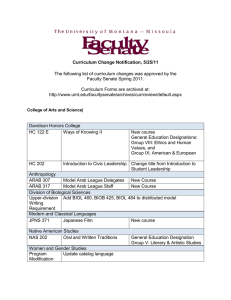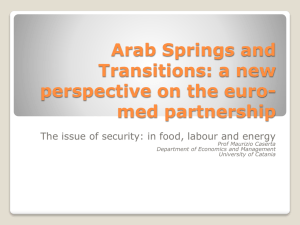Introduction
advertisement
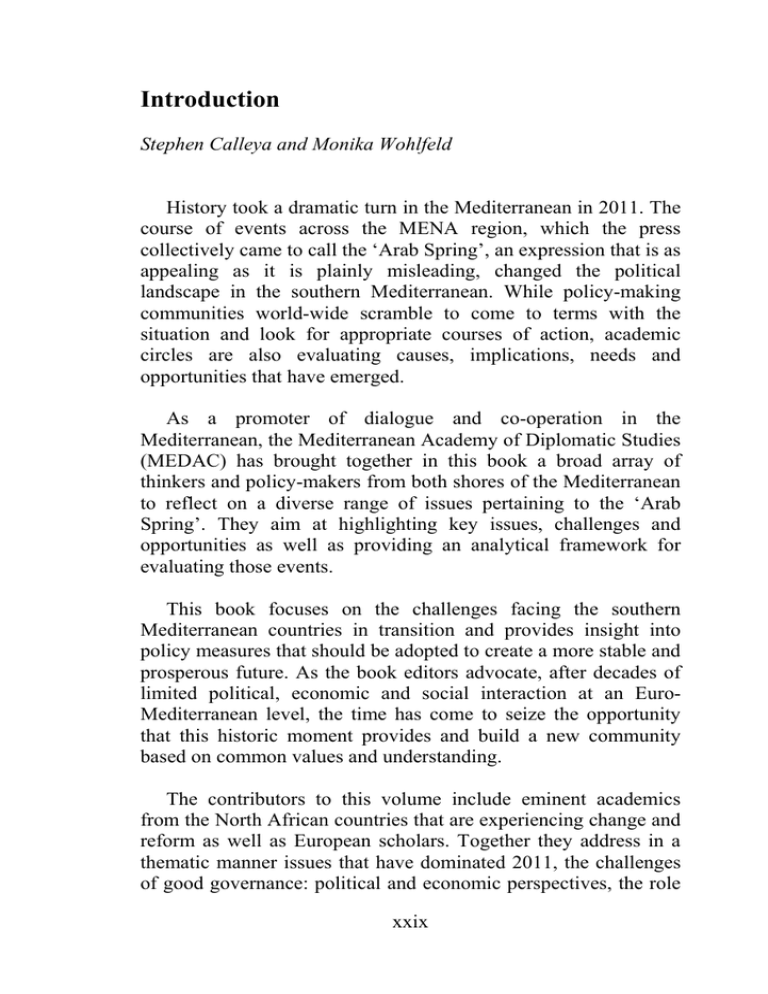
Introduction Stephen Calleya and Monika Wohlfeld History took a dramatic turn in the Mediterranean in 2011. The course of events across the MENA region, which the press collectively came to call the ‘Arab Spring’, an expression that is as appealing as it is plainly misleading, changed the political landscape in the southern Mediterranean. While policy-making communities world-wide scramble to come to terms with the situation and look for appropriate courses of action, academic circles are also evaluating causes, implications, needs and opportunities that have emerged. As a promoter of dialogue and co-operation in the Mediterranean, the Mediterranean Academy of Diplomatic Studies (MEDAC) has brought together in this book a broad array of thinkers and policy-makers from both shores of the Mediterranean to reflect on a diverse range of issues pertaining to the ‘Arab Spring’. They aim at highlighting key issues, challenges and opportunities as well as providing an analytical framework for evaluating those events. This book focuses on the challenges facing the southern Mediterranean countries in transition and provides insight into policy measures that should be adopted to create a more stable and prosperous future. As the book editors advocate, after decades of limited political, economic and social interaction at an EuroMediterranean level, the time has come to seize the opportunity that this historic moment provides and build a new community based on common values and understanding. The contributors to this volume include eminent academics from the North African countries that are experiencing change and reform as well as European scholars. Together they address in a thematic manner issues that have dominated 2011, the challenges of good governance: political and economic perspectives, the role xxix of the civil society, lessons learnt from other regions of the EU Neighborhood, and finally the EU’s responses to challenges in the emerging Mediterranean. In the first section of the volume, entitled ‘The events of 2011’, authors (Eyadat, Driss, Bakr, Khader, Maddy-Weitzmann) propose evaluations of what they respectively call ‘revolutions’ or ‘Arab Spring’. Driss notes that the spontaneous movement in Tunisia developed outside of any political framework, with no evident ideology, and hence he sees the difficulty in calling it’s early days a revolution. Khader argues that there are no revolutions but rather there are many "Arab revolts" that are not necessarily identical in their starting point, their development and their outcome. And in another section of the book, Spencer uses the term Arab awakening, and Lutterbeck ‘uprisings’. This already points to the difficulty of conceptualizing the events in a coherent manner, and providing adequate ways of analyzing them. Driss writes that of ‘the ... possible exit strategies from authoritarianism, it is the most unlikely one that took place’ in Tunis. Maddy-Weitzmann also speaks of Tunisia as an unlikely spark: ‘Tunisia, which for most of its 55 years of independence, has been at the margins of Arab politics, studiously pursuing its own path, in both domestic and foreign affairs, seeking mainly to avoid the embrace of radical and potentially threatening states (Nasser's Egypt, Gaddafi's Libya and Algeria) and political movements (pan-Arabism, Islamism)’. The theme is repeated in other parts of the volume, with for example Ammor stating that ‘This rapid political shift was a surprise to many, including Western research centers’. A number of interesting questions were raised in this section. Why was it so difficult to foresee the coming of this change, despite such popular determination? What were the profound reasons for this phenomenon? And to what extent could this process be reproduced in other Arab countries? Indeed, Eyadat points out that ‘Previous literature on the region and on democratic transitions fails to explain, predict, or determine the possible future of the Arab Revolutions of 2011.’ xxx He suggests that new multilayer and cross-dimensional analytical tools are needed to evaluate the situation on the ground. He urges such studies of events as they occurred so far, as it is unclear which paths the rest of the region will take, and ‘based on social conditions, Algeria, Sudan and Lebanon may likely join the Arab revolutions of 2011’. The Arab contributors to this section show optimism about the future, in particular towards Tunisia. They however caution that the revolutionary processes are not completed and that there are many factors that could influence the outcome. The jury on Egypt is out, as only forthcoming elections will determine the path that Egypt will take. Bakr develops a number of possible scenarios, arguing that depending on the outcome of elections, scenarios can vary from extreme optimism to extreme pessimism. The authors also consider the impact of the positive balance sheet of the events in Tunisia so far. Khader indeed writes that at least intellectuals and human rights defenders now speak of the “Tunisian paradigm", forging a new term in Arabic "tawnassat al arab” (the “tunisianisation” of the Arabs). As for the impact of this ‘tunisianisation’, Khader speculates: ‘There will undoubtedly be change in the other Arab countries. However, one asks under what shape, with what actors and with what blessing will change occur? No one, at this stage, is in a position to say for sure.’ A broad view of the region is provided by Maddy-Weitzmann who analyses the response of the neighbouring and regional states to the events in Tunisia, Egypt and especially Libya and Syria. His geopolitical perspective diagnoses shifts of power and allegiances, while noting the weakness of Arab collective institutions and the parallel reassertion of other identity markers across the Middle East (from the Shi`ites and Kurds of Iraq to the Berber/Amazigh communities in North Africa). He sees events in Syria as a key issue, pointing out that its ‘ultimate fate may help answer the question whether, and to what extent, being "Arab" will still be a meaningful attribute of political identity in the coming years.’ xxxi In the second section, focusing on ‘The challenges of good governance: political and economic perspectives’ the five authors (Grech, Ammor, Tzannatos, Lutterbeck and Pullicino) choose different vantage points to look at what the next steps for countries in transition in North Africa will be. Grech argues that while officials (on both sides of the Mediterranean) argued -explicitly and implicitly- for an Arab exceptionalism towards human rights, the banners under which the various movements in the region fought to depose authoritarian regimes clearly refuted this proposition. He argues that human rights (including the social and economic components) and democratization, understood as the practice of meaningful political participation, were intrinsic to the demands of the Arab populations and that the success of the revolutions will rely on how effectively the new governments respond to these demands. Consequently he urges that attention be focused on the creation of human rights institutions in their broadest sense with an equal emphasis placed on effective human rights education strategies. Ammor focuses on democratic governance (rather than good governance, a term that is widely used, but which he criticizes for seeing rights and freedoms as a mean toward a goal rather than the goal). This concept refers also to people having a say in decisions that affect their lives and holding decision-makers accountable, and to responsiveness of economic and social policies to people’s needs and aspirations. Ammor suggests that the factors wealth, knowledge and power help to analyze events in North Africa. But he also wonders whether new social media should not be added to this shortlist, because one has to be aware of the presence of an educated group with access to modern means of communication. Ammor lists the challenges facing Arab leaders, in particular pointing to ‘the establishment of democratic institutions that guarantee a fundamental separation of powers.’ Tzannatos focuses on the economic challenges. His starting point is rather bleak, as he argues that both coasts of the Mediterranean face crucial and tough economic challenges. In the North, structural problems, that earned the North Mediterranean xxxii economies the unenviable acronym of PIGS (Portugal, Italy, Greece and Spain), have been compounded by the debt crisis in Europe and by unrest and revolutions in the Arab world. What appeared to be a promising start towards the beneficial integration of the North and South Mediterranean coasts is now endangered by the European debt crisis and the Arab political crisis. Both subregions seem, so far, to be adopting crisis reactions rather than structural responses, he chides. Tzannatos indeed argues that Arab governments tempted ‘to buy peace with new spending packages’ would destabilize the Southern Mediterranean region fiscally. The role of the militaries in the various countries of the region is analysed by Lutterbeck. He argues that the link of the military on the one hand to the regime and on the other to the population helps explain the different outcomes of unrest in different countries, and underlining that the role of the military needs to be addressed urgently in order to allow for transition processes and democratization. Finally, Pullicino analyzes the role of the media in the region, focusing on the media landscape in Egypt. She contends that changes have been dramatic and that within the last decade, satellite television, ‘independent’ newspapers and access and use of online tools including social media have transformed the media content the average Egyptian is likely to consume. Her focus is on the extent to which these transformations, coupled with the establishment’s ambivalent attitude towards the media have instigated changes in outlook and behaviour towards the regime. Pullicino claims that significantly in coming to the tipping point, online space crossed over to real space but contends that the struggle for media freedom in Egypt is far from over. In the following section, Spencer, Regan, Halaseh and Walton focus on various aspects of the input and role of the civil society in the changes in North Africa. While considering the changing role of civil society in North Africa, Spencer points out that internet and new media played an xxxiii important role. In the Arab world, the internet has opened up new possibilities for non-violent forms of resistance and exchange. In addition, civic and social actors there are increasingly using links, resources, ideas and organizational methods beyond the confines of the territory of their nation-state. This applies clearly to the cases of protest in 2011 in North Africa and the Arab world. Spencer compellingly argues that there is a clear link between the growth of civic space and the emergence of a private economic sector. The civic space thus requires ‘a minimum of economic independence from the state in order to achieve political and legal rights’. Given the demands on both new and old Southern Mediterranean governments to accelerate reform and create employment, the era of state-led growth strategies may well be reaching a crisis point. Governments cannot provide jobs for all nor respond to rising socio-economic demands at the speed they are being presented with these challenges. It is certainly clear that something has to change – but the real challenge is how to engineer the scale of internal reforms and transitions needed without jeopardizing the stability of the whole. Spencer suggests that the best starting point for managed change would be to identify and focus on new private sector partners, on both sides of the Mediterranean, which are ready to challenge the bias of existing economic models for the benefit of much larger sectors of society. Regan sketches some key dimensions of the role of women in Arab society in recent decades, highlighting their involvement in the independence struggle and in the immediate aftermath of independence and the forms their engagement has taken in different countries and regionally. He outlines the nature of some key struggles today and, finally offers some comments on their more recent role in the ‘Arab Spring’. The role of women across the Arab region in terms of human development and the struggle for human rights and democracy has been the subject of intense discussion within the region and internationally, with some arguing that that ‘feminist’ or ‘gender and development’ perspectives are external and artificial constructions inappropriate xxxiv to the region. But in recent months, women have played a key role in the popular demonstrations and movements. Thus, the rights of women are likely to emerge as a ‘divisive’ issue that some may wish to put aside until other broader objectives are achieved, while others rightly insist that it remains fundamental to the process itself. Youth is the focus of Halaseh. She argues that a paradigm shift is unfolding, whereby young Arabs -the majority of the population- are increasingly realizing an empowered and influential role in all the aspects of public life. The real challenge lies in finding a platform which can bring together those who initiated the revolutions, the larger periphery with those who joined the protests, and the new entities administering the transition. Collective action and mass demonstrations have proven to be successful tools in bringing about change; yet, they are not necessarily constructive tools to manage change. How youth choose to consolidate their achievements is a determining factor as to the role they would play in the design of the new political system. Youth movements must step up their game; especially when the more established parties who have the leadership and the experienced political machinery can co-opt the process of statebuilding for their own goals. New governments must include youth and women into all levels of governance, as democratization cannot be a top-down process. Referring to the example of the Anna Lindh Foundation, created to promote intercultural dialogue and improve perceptions across the two shores of the Mediterranean, Walton analyzes the 'shift' in vision towards the Arab society. Dialogue between Western and Arab societies had been in the past seriously affected by distorted perceptions, particularly during the previous decade. He argues that the events in North Africa will allow increasing dialogue and focusing on similarities rather than differences. Walton lays out the process of adaptation of the Foundation following the initial Arab revolutions: firstly, managing the crisis, next reinforcing its role in the emerging context, and then opening xxxv up new avenues of action based on a bridging concept between the institution’s mission statement and the new needs on the ground. It is a process of adaptation through which the Foundation has rediscovered and reconnected with some of the founding principles and ideas behind its creation, while at the same time identifying new opportunities to increase its impact in the region. In the section on lessons learnt from other regions of the EU neighbourhood, Jones, Hopkinson and Haran undertake the complex task of looking at transition process in Central and Eastern Europe, and deriving the relevant issues and lessons learnt. Jones points out that it is not surprising that the Arab Spring gave rise to comparisons with the anti-communist uprisings in Central and Eastern Europe in 1989, and the collapse of the Soviet Union. It was this comparison that bolstered a sense of the world’s geo-political map being redrawn, and that a new era of relations within and with the Arab nations was beginning. In both cases it was not just popular rejection of a particular government or set of leaders, but a rejection of a type of system that was seen as illegitimate. Although agendas were different and local issues specific, there seems to have been a dominant desire to integrate the society with the outside world. They were modernizing upheavals in favour of individual rights, fairness, and greater opportunity. Jones argues however that many factors distinguish the two historical situations and regions: democratic traditions, the fact that Arab states seems to proceed separately rather than as a group toward change, and most importantly, the draw of the European Union membership prospect that is lacking in North Africa. Hopkinson too suggests that the two sets of uprisings (Central and Eastern Europe and North Africa) are only partially analogous, and that the EU, the major external actor involved in the political and economic transformation of CEEs, is likely to play only a partial and limited role in the transitions in most MENA countries. The key differences for him are that in Central xxxvi Europe there was a single (albeit declining) hegemon, and this hegemon collapsed, whereas in North Africa there are at least two regional powers, which will continue to play this role. In addition, unlike the Communist regimes in CEE, which shared similar political and economic structures, the political structures in the MENA region are more heterogeneous. Hopkinson, like Jones, argues that the key difference is the incentive structures generated by the European Union. Therefore, unless there is a radical rethinking of the EU’s potential geographical finalité politique, the role of the EU in the MENA region will be limited, and a powerful external incentive for reform will not be available. The case of the so called Orange Revolution in Ukraine is studied by Haran. His starting point is that there were high hopes for Ukraine in the wake of the Orange revolution. These were thwarted by events that followed. Haran argues that paradoxically, the process of democratic elections, which started with the Orange Revolution, led to the 2010 electoral victory of the candidate, who lost the 2004 election in disgrace and who is now trying to revert the country back in many ways to where it had been in terms of democracy. It is important to understand what went wrong to draw from the experiences and lessons learnt from the Orange Revolution and apply them to the revolutionary forces in Tunisia and Egypt. First, the results of revolutions which bring about freedoms should be institutionalized. Second, revolutionary change is a complicated and long-term process. Third, the role of outside influence is vital, and ‘carrots’ must be provided. Criticism only stimulates isolationism, anti-Western rhetoric or even defensive actions. The role of Turkey is analyzed by Bahri and Balcer, from different perspectives. Bahri asks the following questions: What role can Turkey play in the MENA Region? What can the aspiring democracies of the Arab world learn from Turkey? How relevant is the Turkish experience to the future of democracy in the Arab World? Bahri acknowledges that since 2007, Turkey has been gradually moving closer to the Middle East and Eastern Mediterranean. But he takes a cautious approach arguing that the xxxvii Arab states in transition should look to Europe for inspiration and for models (as Europe has been the inspiration and model for Turkey). Turkey’s democratic deficits lead Bahri to question the possibility of Turkey acting as a model for the region’s countries. Bahri argues also that Turkey should not build up expectations of involvement but rather it should carefully and conscientiously draw lessons from its past experiences with the MENA region. Turkey could become a valuable model if the steps necessary to complete the negotiation process with the EU would be undertaken, but Bahri cautions that this is a long and rough road. Balcer takes a somewhat different view. In his opinion, the EU and Turkey are two players for whom the outcome of the processes of democratization and modernization has an enormous importance. At the same time, both sides, as external stake holders in the region, possess a huge potential to influence the course of events either positively or negatively. Balcer looks at strengths and weaknesses of Turkey as model for the Arab world, and concludes that Turkey will remain an attractive source of inspiration for Arabs, provided that it becomes a fully democratic country and continues to be the democratisation leader in this region. Arabs’ expectations with regard to Turkey will grow as they themselves become more democratised. Ankara may provide tangible support to reforms in Arab countries by sharing its experience. The rapidly developing Turkish economy could become a driving engine for some Arab states. Particularly important is Turkey’s potential to impact on mainstream Islamic circles, whose influence is likely to grow significantly in the immediate future. The realization of this scenario would be boosted by the reactivation of Turkey’s negotiation talks with the European Union. In the final section of the book, Marchetti and Calleya provide an assessment of EU’s policies towards the region. Calleya reviews the plethora of EU initiatives towards the Mediterranean during the post-Cold War period and argues that a more coherent cooperative relationship needs to be sought between Europe and the Southern Mediterranean. The dramatic events of 2011 present xxxviii a unique historic opportunity that the EU must support if it wants to be a credible actor on the international stage. It must refocus policy-making on strategic objectives enshrined in the Barcelona Declaration of 1995 and implement the dynamic agenda that supports these states that seriously undertake reforming the political and economic dimensions of their societies. Marchetti analyses the policies of the European Union, aimed at creating a ‘ring of friends’, to the east and to the south, arguing that the EU should pay and is paying increasing attention to its neighbors. However, he criticizes the EU policies for creating tensions between short-term goal of stability and long-strategies aimed at promoting common values. Ultimately, Marchetti finds it questionable for the EU to continue and maintain a rather strict regime of ‘ins’ and ‘outs’ in the context of EU membership. The EU will have to consider possibilities of increasing cooperation incentives by opening up the European integration project to its neighbours in the Southern Mediterranean. However, he raises the question of the political willingness of EU states which are faced with their own problems. Two important facets of relations between the EU and Southern Mediterranean, migration and energy security, are analyzed by Mainwaring and Weissenbacher. Mainwaring observes that the events of 2011 prompted new migratory flows out of the Southern Mediterranean region. A small fraction of those unable to secure air travel have chosen to board boats, especially from Libya and Tunisia, and made their way across the Mediterranean to Europe in search of security. Mainwaring assesses the EU’s reaction to migration flows into the bloc, in particular from Libya. The civil war in Libya brought about an end to Gaddafi’s cooperation in deterring migrants from leaving Libyan shores in the first place, but also in accepting the return of migrants intercepted by Italy and Malta on the high seas. Without this cooperation, the migration from Libya has struck at the heart of EU solidarity, revealing fractured relationships. Mainwaring points out that much higher numbers of migrants have travelled to countries neighbours to Libya and Tunisia. Moreover, the level of xxxix immigration into southern Europe, as a result of the Arab Spring, is not significantly different from that of previous years. Contextualising the migration in time and space, thus, begs the question of who gains from the rhetoric of ‘invasion’, and what such a response indicates about the state of the European Union. Analyzing the energy security situation in the Mediterranean, Weissenbacher points out that energy security requires long-term planning and thus instability could have disastrous consequences, with investments into renewable energy being the most affected. The current atmosphere of instability is not restricted to the southern and eastern Mediterranean, and further economic downturn in the northern Mediterranean would dampen the growing energy demand in the Mediterranean and may cause the European Union to be less willing and able to finance EuroMediterranean cooperation projects. However, at the same time this period of change may bring about opportunities. New governments in the southern and eastern Mediterranean might address many of the outstanding and diffcult issues. They might collaborate more with one another; they might harmonize rules and standards at the regional level, and reduce the massive subsidies to energy consumption; they also might attempt to decrease the region’s energy import and fossil fuel energy dependency, invest in energy efficiency measures, and accelerate the development of renewable energy options. All these measures will be necessary to allow this region of soaring projected energy demand to prosper. Finally, Wohlfeld argues that apart from the EU, there may be other European frameworks that have experience in supporting democratization and transition processes that should not be overlooked as potential sources of expertise for North Africa in the wake of the Arab Spring. The OSCE has an established Mediterranean dialogue, which allowed its participating States to involve a number of Mediterranean Partner States in its processes and work in the form of what could be called observers. The OSCE could become a much more interesting resource for the countries in transition in North Africa, but for this, the OSCE xl would have to review its current practices and develop a vision for its role outside of its region of membership. The various contributions highlight the multitude of issues facing first and foremost the policy-makers of countries in transition in the southern Mediterranean. But they also indicate the challenges in understanding the processes in the region, and assessing in which ways to best support the transition that confront the states of the larger Mediterranean region more generally and EU countries specifically. Previous revolutionary upheavals that took place in Central and Eastern Europe provide some valid reference points and lessons learnt, but those have to be treated with caution as substantial context-specific differences exist. The timing of the Arab Spring, which coincides with financial and economic crises in the EU and in the entire Mediterranean region, may make it difficult to formulate clear responses and provide adequate incentives for change. But after years of political, social and economic stagnation in the MENA region, the events of 2011 provide new opportunities for the creation of a more stable and coherent region, if dealt with appropriately. It would thus be shortsighted for policy-makers in the EU to pass up this historical opportunity. It is the role of commentators and academics from both shores of the Mediterranean to highlight both potential payoffs of decisive and supportive context-specific actions and potential costs and dangers of ignoring the events that unfolded and their implications. xli
